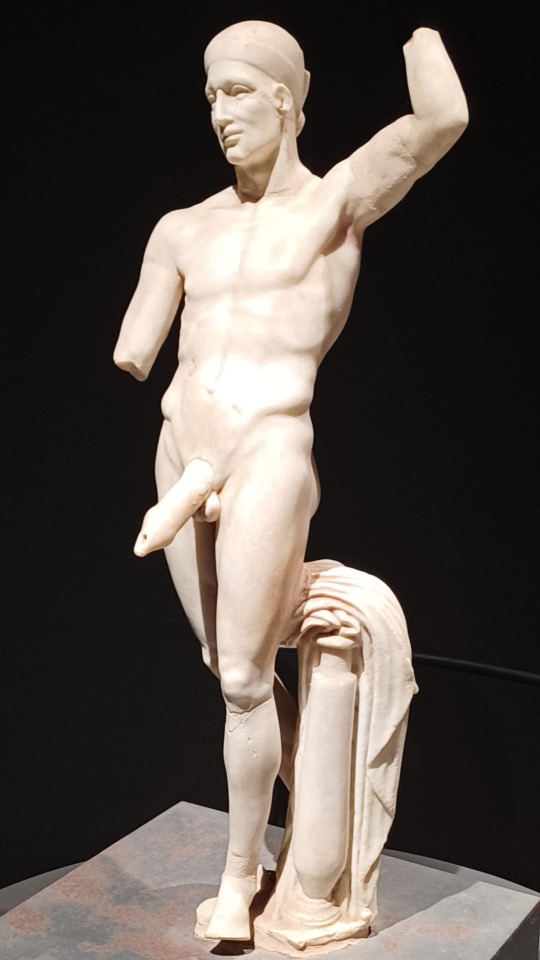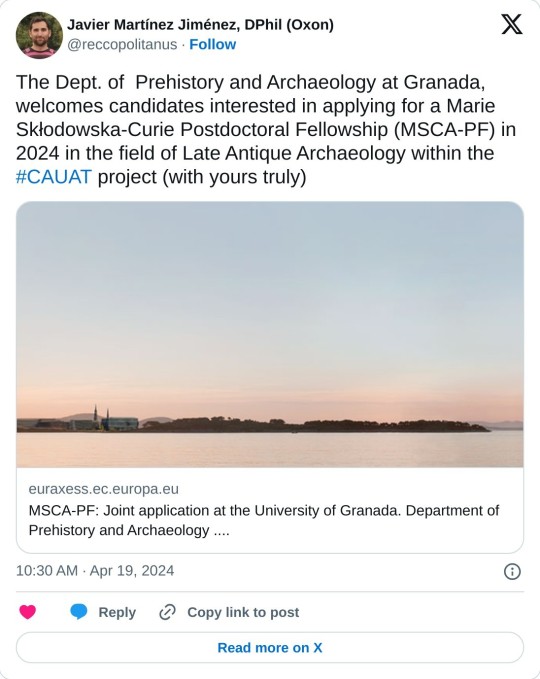#archaelogy
Explore tagged Tumblr posts
Text
We have similar combs to that in equine care in modern times so I'm not overly surprised that the replica works, nor that it works so well.
I've mainly seen these sorts of combs used for mane and tail care because, like our own hair, they work pretty well for teasing out knots, countering too much frizz, and can help work stuff like shampoos and oils into the hair. I HAVE also used them on the main coat before, especially when neigh neigh is shedding because omfg do horses have a LOT of hair.
And its hair not fur for horses in case there are those who don't know.
Edit: I'm not talking about clickerpunk in my following aside, I'm speaking informally and using "you" as a generic term. I'm also info dumping because that's what I do. I'm not criticising or judging clickerpunk in any way here, my concern in my aside is with people who have no prior knowledge or experience with horses mistakenly using videos without caring for the context of those videos to do things they think is okay in all situations or regularly.
Minor aside:
It's generally not advised to groom horses when they are wet, damp, or muddy because of the risks and complications of doing so.
Wet mud will get worked into the coat right down to the skin instead of coming out if you don't allow the coat to dry first. Dried mud flakes off and is much, much easier to handle.
Of course, if you have issues with dried mud in awkward places (or matted too close to the skin that it pulls uncomfortably when you try to brush it out) you can lightly soften it with a damp cloth and tease it out with a comb before letting it dry again and removing the remainder normally.
Ultimately, grooming a wet horse is not advised because you work the moisture into the coat and down to the skin which can chill them. For horses that have double layer coats (like Icelandic horses/ponies and a number of native breeds tbf), they have a second layer below the top coat to help keep warmth in so you can understand how working the moisture down into that second layer isn't a great idea in colder conditions.
The coat can also be damaged by grooming when wet because hair can tangle, break, or become matted as well. The risk increases when there's mud involved since, as mentioned, that works down to the skin and can cause skin irritation as well.
Mud fever is a condition that usually occurs on a horses legs where mud works in deep into the feathers on their legs, bacteria breeds, and causes skin irritation. It's not fun for horses to deal with, is very itchy, and painful as scabs and sores can form. It can cause lameness and even affect the muscle tissue if not treated.
A brief test of a brush/comb isn't too bad but I'm worried about anyone watching this who are new to, or had no experience with, horses and incorrectly assume that wet grooming is fine.
I remember how I once got a proper telling off as an 11yo when I tried to groom a horse that was slightly damp from a brief rainshower, complete with a detailed lecture on why its a Bad Idea and "to never do that again" which has stuck with me even 20+ years later lol.



Rudi got to be part of some experimental archeology today! Testing if this large comb found in the Oseberg viking grave could have been a horse brush/comb! It was super interesting to see how well it actually worked on her shedding winter coat.
(This one was a beautiful replica made by Knut Roger Brekke, not the real one obviously)
7K notes
·
View notes
Text

Sumerian/Mesopotamian Amulet Seal in the Form of a Bull, c. 3250 BCE.
#history#archaelogy#artifacts#art history#old art#art#statue#ancient history#bronze age#iron age#neolithic#mesopotamia#sumerian#iraqi#historical#cute#ancient civilizations
12K notes
·
View notes
Text


Two Satyrs (mosaic) , 4th century BC , Eretria (Evia Island)-Greece
(New Archaeological Discovery/ photos: Ministry of Culture)
#greek#art#art history#τέχνη#mosaic#satyrs#greek mythology#archaeological site#archaelogy#archaelogical#ancient art#excavation#archaeological#discovery#greece#symposium#dance#music#homoerotic art
620 notes
·
View notes
Text

Columns | Athens
#athens#greece#architecture#ancient architecture#ancient ruins#ruins#travel#column#columns#original photographers#photographers on tumblr#ancient greece#greek#art#history#antiquity#classical#temples#europe#archaelogy
802 notes
·
View notes
Text


7K notes
·
View notes
Text

Statua fontana di Priapo, (fine I sec. a.C. - inizio I sec.), dalla Casa dei Vettii - Parco archeologico di Pompei, Napoli.
#priapus#pompeii#pompeii ruins#naples#art#archaelogy#napoli#art history#water fountain#fountain#marble statue
1K notes
·
View notes
Text
JOB ALERT: MSCA-PF Joint application at the University of Granada (Spain) Department of Prehistory and Archaeology

If anyone is interested in a two-year MSCA Postdoctoral Fellowship at the University of Granada within the field of late antique archaeology, please check this link with the basic information.
#Archaelogy#Acedemia#graduate job#postdoctoral job#late antiquity#if anyone applies and mentions they saw this on tumblr they'll get all my support forever
56 notes
·
View notes
Text









A walk in the Archaeological park of ancient Dion, Macedonia, Greece. The Hellenistic theatre has been recently renovated, beautiful news. Definitely, one of my most favourite places in Greece, perhaps less known than other attractions, yet emanating the vibes of mount Olympus, it is said that Orpheus was killed there by the furious maenads, a Dionysian worship is still felt today if someone is still open to such parallel realms. The greenery is another plus, green energy being rejuvenating for both body and soul.
Photos: Vera Bousiou
#mythology#art#ancient greece#dionysus#greek mythology#ancient dion#macedonia#greece#landscape#photography#archaelogy#orpheus#mount olympus#history#nature#ruins#ancient city
28 notes
·
View notes
Text
“No human endeavor has been more associated with mystery than the huge, ancient lion that has a human head and is seemingly resting on the rocky plateau a stroll from the great pyramids. Fortunately for Lehner, it wasn’t just a metaphor that the Sphinx is a riddle. Little was known for certain about who erected it or when, what it represented and precisely how it related to the pharaonic monuments nearby. So Lehner settled in, working for five years out of a makeshift office between the Sphinx’s colossal paws, subsisting on Nescafé and cheese sandwiches while he examined every square inch of the structure. He remembers “climbing all over the Sphinx like the Lilliputians on Gulliver, and mapping it stone by stone.” The result was a uniquely detailed picture of the statue’s worn, patched surface, which had been subjected to at least five major restoration efforts since 1,400 B.C. The research earned him a doctorate in Egyptology at Yale.”
8 notes
·
View notes
Text


Excerpt from “History and Current Debates of Archaeology in Island Southeast Asia” (2019) by Hsiao-chun Hung
#southeast asia#island southeast asia#human migration#prehistory#archeology#archaelogy#austronesian#austroasiatic#x
5 notes
·
View notes
Text
I'm really interested of topics like the Bermuda Triangle, Mermaids, Galaxies, Agartha, The Lost City of Atlantis, Area 51, and Ancient Civilizations. I’m also intrigued by the mysteries of the Dinosaur Age, Aliens, Time Travel, Greek Mythology, Reincarnation, and Creepy Stories. These subjects ignite my curiosity and raise countless questions about the unknown, unexplained phenomena, and what lies beyond our current understanding of reality.
4 notes
·
View notes
Text

Lioness Devouring a Man, Phoenician Ivory Panel, c. 9th-8th century BCE. From the palace of Ashurnasirpal II, Nimrud, northern Mesopotamia, Iraq.
#history#culture#old art#artwork#art#ancient history#mesopotamia#ancient civilizations#anthropology#archaelogy#middle eastern#iraqi#iraq
6K notes
·
View notes
Text



Church of Saint George the Trophy-bearer (11th century), Anthidona (eastern Boeotia)-Greece / fresco : Saint George, early 17th century (Theban school)
(ph. Yorgos Yannakos, June 26-2024)
#greek#byzantine art#byzantium#orthodox christianity#christianity#saint george#religious art#church#architecture#religious architecture#greece#fresco#11th century#17th century#archaelogy#monument
39 notes
·
View notes
Text

Columns At Sunset | Athens
#athens#greece#architecture#ancient architecture#ancient ruins#ruins#travel#column#columns#original photographers#photographers on tumblr#ancient greece#greek#art#history#antiquity#classical#temples#europe#archaelogy
664 notes
·
View notes
Text










2K notes
·
View notes
Text
Things get stranger and more understandable when you read that I lived in a cave, alone, for years. HEKATE
It was a K like KORN like children of the corn like there's corn in Indiana. Indiana was the name of the dog, not the Archaeologist. What did they find in my tomb? Did they find my box? DID IT HAVE THE SUN ON IT? Did they open it? Did they find my dagger and snakes? What else did they find in there? It was down there out in TURKEY.
#korn#hekate#hecate#angels#demons#gods#good omens#cave#archaelogy#archaelogist#hecate's tomb#hecate's dagger#hecate's box#pandora#josh gates#aziraphale#chaos#indiana jones#there's more than corn in indiana#crowley#crow boy#trust#magic#the magnificent seven#goddess#wren bird#nightingale
4 notes
·
View notes